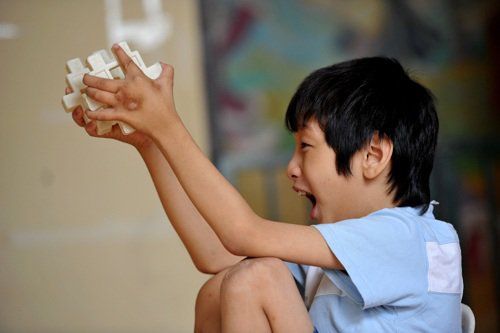This is an automatically translated article.
Psychology-Educational Unit - Autism, Vinmec Times City International Hospital with intervention services is always innovative and diverse in form and high quality in order to maximize the effectiveness of children's education. Designing intervention hours for children with autism is part of an intervention program - Educating children with autism contributes to the development of a therapeutic educational plan for children - this is a guideline throughout the process of care and support young1. Factors to consider when designing intervention hours for children with autism
When designing activities for children, it is necessary to learn a number of factors: children can focus their attention to the maximum extent, promote children's strengths and true interests of children, external environmental factors such as: weather, time, or the arrangement of the room... From a psychological perspective, we will learn about a few factors that affect the design of intervention hours for children below.1.1. How is the child's concentration? The ability to focus attention will help children maintain their activities, and at the same time absorb what other people instruct. Parents need to determine the child's ability to focus attention, for example: the child's best attention span at what time of day, the child's attention span on each activity (for example, children like to watch the phone, can sit and watch all day without getting bored, but with other activities can only concentrate for 1 minute), how long is the highest ability to focus attention in each activity... Only then can we offer activities with a suitable time, to ensure that children can focus and pay attention without getting bored. If a child can only sit 5 flowers, he is bored, then he will start from 3 flowers, then gradually increase the number to 5 - 7 - 10 flowers so that the child can get used to and accept the sitting for a long time. If the child's concentration limit is not known, setting the time too short will not improve the child's skills, and if the time is too long, it can make the child uncomfortable and explosive.
1.2. What is the child's interest? When designing the intervention session, the child's interests/interests cannot be ignored. Because this is the motivation – the reward (as behavioral psychology calls it) – the reason to want to work and the factor that motivates children to imitate a behavior of others (according to the social learning theory). festival). In order to arrange activities accordingly, parents should know what activities their children like, what toys they like, how they like social interactive games or if they like flower sets, and they like boards. letters or spinning the wheel... Children's interests can be used as an opening activity for an intervention, or as a reward for when they're done.
1.3. Goal Each child - every day has a different state, some days the child will be happier, but there are days when the weather changes, the child is more uncomfortable. Therefore, setting goals - what children need to achieve - in class that day is extremely necessary. The goal of an intervention may be a small part of a pre-planned plan, but can be changed based on the child's attitude that day to be flexible. Setting the goal of the intervention time will help parents arrange activities accordingly and also help relieve the children's emotions.

Có 3 điều cần chú ý khi thực hiện can thiệp trẻ tự kỷ là mức độ tập trung, sự hứng thú và mục tiêu
2. Some examples of the structure of intervention hours for children with autism
One hour of individual intervention usually lasts 45-60 minutes. During that time, based on the factors listed above, consideration should be given to arranging activities that are appropriate for the whole child. Before and after the child's intervention, the child may need to participate in other intervention hours (with a multidisciplinary intervention model) or other activities (eg mealtime, playtime, or school group time). preschool, or activities at home). Parents can refer to the examples below and choose the activities that are right for their children:2.1. Case 1 Take, for example, a child with relatively severe autism who understands only short commands at close range and must be followed immediately, with physical support. Children often run around, refuse to sit still, poor eye contact. Children just love to tear paper and run around the room.
With such children, the likelihood of them participating in static activities or needing to sit at a table is very low. We can offer 2 to 3 short and rotating activities to get the child's attention and cooperation.
First, after entering the room and putting away all personal belongings, children are allowed to run around – play freely for 2-3 minutes, the purpose is for children to get used to, accept and feel safe in the environment. this, in addition to let the child release pent-up energy from the previous period. During these 3 minutes, the child is allowed to be free, with activities such as tossing chairs, running in the corner, tearing paper... until the therapist asks to stop. The activities then, depending on the "product" that the child leaves after the 3-minute free time, so that the parents can offer it accordingly. For example, if a child tears a paper, or throws an object before, parents need to ask the child to pick it up and put it in the right place – accepted as a therapeutic activity. If the child only runs and jumps without affecting the furniture, they can move on to the first activity. The first activity that can be selected is interactive play, the game “Chi cha chi chi” or “Count and pull fingers”. If the choice of goal is to increase eye contact and increase the child's ability to sit still, parents can help the child sit in the chair and play with the child. At first, the child will have difficulty sitting still in the chair, and uncomfortable when others hold his or her hand, but parents should play, as fast as possible, lasting about 30 seconds, then let the child run. out of place within 1-2 minutes. Go on, pull the child in again and play that interactive game, still the same 30 seconds, and add an extra rest. By the 3rd play, things need to be a little slower, there is an emphasis in the rhythm when playing. For example, when reading the rhyme "The father is shrewd, the mother wears . . ....". Between the sentences of the rhyme, parents can pause, lengthen the sentence combined with eye contact and observe the child's behavior. Similarly, in later plays, the rhythm lengthens, the activity slows down, the time the child sits still in the chair waiting for the surprise and eye contact with the parent will be prolonged. The second activity that can be selected is a motor activity – the reward for sitting still in the chair in the previous activity. Parents can arrange chairs in a long line, let the children step over and practice jumping with their feet down. Or let the child bounce, roll, jump on the ball... Because children understand poorly, parents need to give verbal instructions, combined with physical help for the child (take the child by the hand or support the child's feet to walk). right direction). This activity can also last 2-3 minutes/play and gradually increase in later plays. A third activity that can be selected is an activity that requires sitting still in a chair, such as looking at a picture card or pointing at a picture card. With the child in the example above, the goal for this activity is for the child to sit still and focus on the card. Parents can swap picture cards to attract children's attention. The shuffling time is fast at first, then slows down so that the child has a chance to look at the pictures in the picture, instead of dodging. The three activities above are very simple activities, with little cooperation, can do all 3 activities and cycle continuously to make sure the child can follow along without getting bored.

Mỗi buổi can thiệp trẻ tự kỷ thường kéo dài 45 - 60 phút
In a period of 45 - 60 minutes, you can give 3 - 4 activities alternating between what the child likes - what the parent wants. The initial time is still free play, doing whatever the child likes without parents interfering for 2-3 minutes - is a way to welcome children to the lesson "Now you can run or do whatever you want, until When mom calls, we'll start studying." A word of guidance will not be superfluous, and helps children understand their limits. The first activity chosen should be the one that the child wants – let the child express it by getting it himself, or the parents ask and the child chooses. The second activity should be the activity the parents designate – should choose an activity that requires sitting still in the chair – because at this time the child is not bored yet, and can focus on listening to the instructions. Some activities that can be done are stringing flowers, stringing beads, practicing picking with scissors/chopsticks, spoons, coloring, cutting paper freely... The difficulty of the activities depends on the current level of the child, and need to gradually increase the difficulty by day, to ensure that children can practice daily without getting bored. Or if the child can concentrate for a long time, instruct the child to sit still and listen to the story (use a story with many pictures and few words)... The third and fourth activities can be the activities that the parent only activities or activities that your child enjoys. These activities can be sedentary but do not have to be very quiet, such as jigsaw puzzles, reading and looking at picture cards, playing with mushrooms, smashing balls, smashing mice, cutting fruit. .. Or motor activities such as climbing a chair, rolling the ball back and forth.... Because at this time the child may be a little distracted, and the ability to concentrate is not as high as at first, there should be some activities to engage children to maintain cooperation. These activities do not need to be repeated a second time during the intervention session (i.e., at the end of the activity, there will be a complete transition to the new game, without turning back), but should be repeated on a daily basis with varying degrees of intensity. increasing difficulty.
The list of activities/games on the internet is now many and varied, parents can rely on their interests/ability to focus attention to arrange to suit their children, so that both parents and children are interested and perform well in the activities set out. And it should also be noted that there is always a break between activities (lasting 1-2 minutes) for the child to be balanced and comfortable.
Please dial HOTLINE for more information or register for an appointment HERE. Download MyVinmec app to make appointments faster and to manage your bookings easily.













